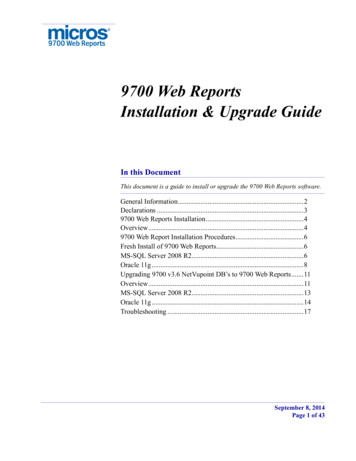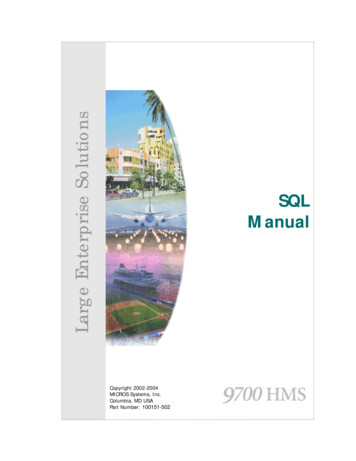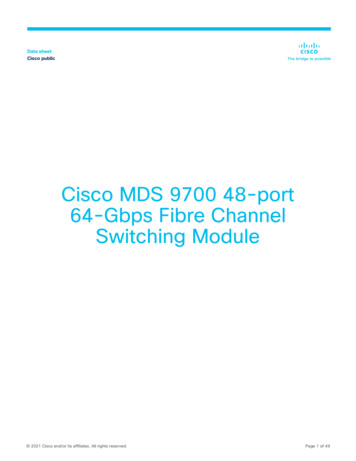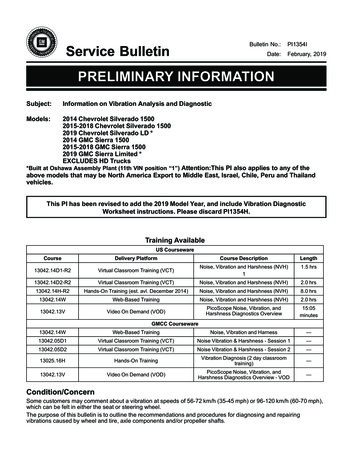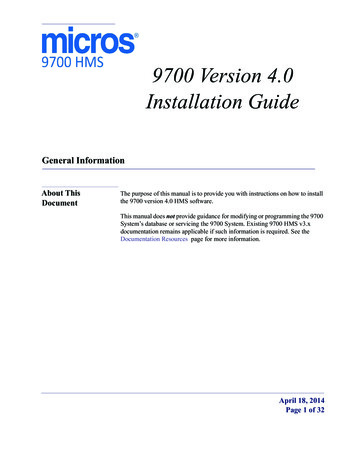
Transcription
9700 Version 4.0Installation GuideGeneral InformationAbout ThisDocumentThe purpose of this manual is to provide you with instructions on how to installthe 9700 version 4.0 HMS software.This manual does not provide guidance for modifying or programming the 9700System’s database or servicing the 9700 System. Existing 9700 HMS v3.xdocumentation remains applicable if such information is required. See theDocumentation Resources page for more information.April 18, 2014Page 1 of 32
General ugh the best efforts are made to ensure that the information in thisdocument is complete and correct, MICROS Systems, Inc. makes no warrantyof any kind with regard to this material, including but limited to the impliedwarranties of marketability and fitness for a particular purpose.Information in this document is subject to change without notice.No part of this document may be reproduced or transmitted in any form or byany means, electronic or mechanical, including photocopying, recording, orinformation recording and retrieval systems, for any purpose other than forpersonal use, without the express written permission of MICROS Systems, Inc.MICROS Systems, Inc. shall not be liable for errors contained herein or forincidental or consequential damages in connections with the furnishing,performance, or use of this document.TrademarksAdobe FrameMaker is a registered trademark of Adobe Systems Incorporated.The following are registered trademarks of the Microsoft Corporation;Operating Systems - Microsoft Windows Server 2008 R2.Database Platforms - Microsoft SQL Server 2008 R2.The following are registered trademarks of the Oracle Corporation;Oracle 11g.Other products - Microsoft Excel, Win32 and Windows CE.Visio is a registered trademark of Visio Corporation.All other trademarks are the property of their respective owners.Printing HistoryApril 18, 2014Page 2 of 38New editions of this guide incorporate new and changed material since theprevious edition. Minor corrections and updates may be incorporated intoreprints of the current edition without changing the publication date or theedition number.EditionMonthYearSoftware Version1stAugust20134.02ndApril20144.0
General InformationWho Should Be Reading This DocumentWho Should BeReading ThisDocumentWhat the ReaderShould AlreadyKnowThis document is intended for the following audiences: MICROS Installers/Programmers MICROS Dealers MICROS Customer Service Representatives MICROS Training Personnel MIS PersonnelThis document assumes that the reader has the following knowledge orexpertise: Operational understanding of PCs Understanding of basic network concepts Experience with Microsoft Windows Server 2008 R2 Experience with Microsoft SQL Server 2008 R2 or Oracle 11gApril 18, 2014Page 3 of 38
General InformationDocumentation ResourcesDocumentationResourcesApril 18, 2014Page 4 of 38The following documents have been updated with information and proceduresneeded to maintain PCI-compliance and must be consulted for security purposesprior to upgrading from 9700 HMS Version 3.1 SP5 and below to 9700 HMSv3.6 and above. These documents are available on the MICROS 9700 HMSProduct page of the MICROS Member Services website. 9700 v4.0 PA-DSS Implementation Guide: This document is a quickreference guide that provides information concerning MICROS’ adherenceto the PCI Data Security Standard and Payment Application Data SecurityStandard (PA-DSS) compliance. 9700 Version 4.0 General Release ReadMe First: This document reviewsdetails about new Features, Enhancements and Revisions that occurbetween Service Pack and version releases. 9700 Secure Default Account Handling: This document contains detailedinformation on 9700 v. 4x secure default account handling procedures.These procedures must be followed to prevent compromised security andmaintain PCI compliancy. 9700 v4.0 Security Guide: This document describes 9700’s security design,features that monitor employees’ actions taken on the system, and featuresthat restrict employee access to the database, reports, and operationalprocedures. 9700 Upgrade Best Practices: This document is intended to convey the bestpractice information when upgrading the 9700 HMS application from anon-PCI compliant version (version 2.x) to a PCI compliant version(versions 3.x and greater). MICROS 9700 v4.0 Key Manager Application Manual: This document is aquick reference guide that provides information concerning the 9700Encryption Key Management Utility, which allows the user to set theencryption passphrase for the 9700 system. MICROS Secure Wipe Tool: This document provides instructions on how todownload and use the secure wipe tool Eraser. The secure deletion of data isnecessary when upgrading a non-PCI compliant version of a MICROSsoftware application or when customer data has been collected fortroubleshooting purposes and is no longer needed. Wireless Networking Best Practices: This document explains the stepsnecessary to connect a wireless workstation for PCI-compliance.
General InformationSystem SecuritySystem SecurityWhen the Server is Not on the Domain: Configuring Remote RMC ina Windows Workgroup EnvironmentDue to PCI security requirements, the 9700 installation asks if the site processescredit card transactions through the system, as shown below.If the site is using remote a Remote Management Console (RMC), credit cardsare processed through the 9700 system, and the server is not on the domain, thenthe following prompt will display:After clicking ‘OK’ to close the prompt, follow the procedures listed below tomaintain Payment Card Industry (PCI) compliance in a Windows Workgroupenvironment when both credit cards and a remote RMC are used. Follow thesteps below after the system has been updated to 9700 3.10 SP6 or a higherversion of software, and the server has been rebooted.April 18, 2014Page 5 of 38
General InformationSystem Security1. From the Windows Start menu on the 9700 server, select All Programs MICROS Applications Create User Utility.2. When prompted, enter a unique user name and a strong password consistingof at least eight characters and include at least one number and one specialcharacter (!@# % ). Confirm the password and select ‘Create’. Do not usea default ‘User name’ or ‘Password’.3. Select ‘OK’ after the “User successfully added” message is displayed:4. Select ‘Close’ within the ‘Create User’ applet.5. After a remote RMC is installed on the client workstation and updated tomatch the server version, from the Windows Start menu select AllPrograms MICROS Applications Create User Utility.April 18, 2014Page 6 of 38
General InformationSystem Security6. When prompted, enter the identical ‘User name’ and ‘Password’ previouslyused on the server and then select ‘Create’.April 18, 2014Page 7 of 38
9700 HMS Version 4.0 General ReleaseOverview9700 HMS Version 4.0 General ReleaseOverview9700 HMS v4.0 was developed in order to support its installation on MicrosoftWindows Server 2008 R2 (64-bit). Additionally, support has been added forutilizing either Microsoft SQL Server 2008 R2 or Oracle 11g as possibledatabase platforms.Please see the 9700 Version 4.0 General Release ReadMe First document that’savailable on the MICROS 9700 HMS Product page of the MICROS MemberServices website for more information.Software LicensingThe 9700 software licensing method uses a USB port hardware key to controlfeature licensing. To stay current with the changes in server architecture, butalso provide a solution for legacy hardware, MICROS also offers a keylesslicensing solution, which is suitable for both old and new systems. Keylicensing is transparent to the user, and integrates seamlessly, using a singleapplication to provide support to both the traditional hardware key and keylesslicensing. The keyless licensing feature is automatically activated when ahardware key licensing code is not detected. A unique licensing code, generatedby using information from the server’s motherboard, ensures that the code isunique to each server.9700 v4.0 software licensing procedures remain the same as previous versionswith the exception of the addition of a new activation code named ‘Feat 4xCode’. It may be located in the EMC Configurator System Parameters Order Types and Activation Codes tab in the 9700 4.x Activation Code section.This code must be ordered and entered for a 9700 HMS v4.0 system to operatefor either Keyless or USB key licensing methods. Demo mode will continue tofunction as in previous versions.For information on how to obtain keyless licensing, go slicensing.April 18, 2014Page 8 of 38
Installing the 9700 HMS v4.0 ApplicationBefore you BeginInstalling the 9700 HMS v4.0 ApplicationThis section will guide you through the steps to install or upgrade to the 9700HMS v4.0 System on the server.The instructions in this section assume that you have installed and configuredthe following elements on the 9700 application server:Before you Begin Microsoft Windows Server 2008 R2 operating system Microsoft SQL Server 2008 or Oracle 11g — this does not need to beinstalled on the 9700 server, but must be available on the network. Internet Explorer 8.0 Install Internet Information Services (IIS). Ensure that the IIS v6 ManagementCompatibility services are selected when installing IIS. See the Appendix for moreinformation about installing IIS. Install .NET Framework 2.0.Before installing the 9700 System software, the following should be noted:1. For those performing an upgrade on a 9700 v3.x system, perform a databasebackup task for both the Transactional and Reporting databases.2. MICROS strongly recommends a Uninterruptible Power Supply (UPS) beinstalled on every MICROS 9700 System.3. Follow the prompts in the 9700 System software installation. If you cancelthe installation after it starts, using any method other than through theprovided prompts; the results can be unpredictable.4. The individual installing the software must be logged on as “Administrator”before running 9700 Setup on a Windows system.5. Ensure that all other programs/applications are closed on the PC. If thesystem detects an active program/process during the installation routine, anotification to close them may display.April 18, 2014Page 9 of 38
Installing the 9700 HMS v4.0 ApplicationBefore you Begin6. When configuring 9700 through the 9700 Enterprise Management Console(EMC), 9700 RMC or EMC AutoSequencer module, use the forward slash(/), rather than the standard Windows backward slash (\).7. SDelete must be downloaded and installed on the same drive as theoperating system in a folder named “SDelete” (typically C:\SDelete).SDelete.exe is a command line utility that is used to the securely delete oneor more files and/or directories and is also used by the MICROS 9700Encryption Key Management Utility. For more information on SDelete andto download SDelete, see the “SDelete v1.61” page on the Microsoft TechNet website 897443.aspxFor more information about the MICROS 9700 Encryption Key ManagementUtility, see the MICROS 9700 v4.0 Key Manager Application Manual that’savailable on the MICROS 9700 HMS Product page of the MICROS MemberServices website.April 18, 2014Page 10 of 38
Installing 9700 Version 4.00 - MS-SQL Server 2008 R29700 v4.0 Software InstallationInstalling 9700 Version 4.00 - MS-SQL Server 2008 R29700 v4.0 SoftwareInstallation1. Close all programs and return to the Windows Desktop.2. Start the 9700 Version 4.0 installation program. The 9700 HMS 4 splashscreen displays briefly.April 18, 2014Page 11 of 38
Installing 9700 Version 4.00 - MS-SQL Server 2008 R29700 v4.0 Software Installation.and then the main installation screen. The Welcome to the InstallShield Wizardfor 9700 HMS screen displays.3. Click ‘Next’ to continue the installation.April 18, 2014Page 12 of 38
Installing 9700 Version 4.00 - MS-SQL Server 2008 R29700 v4.0 Software Installation4. The Customer Information screen displays. Enter the ‘User Name’ and‘Company Name’ and click ‘Next’ to continue the installation.April 18, 2014Page 13 of 38
Installing 9700 Version 4.00 - MS-SQL Server 2008 R29700 v4.0 Software Installation5. The Feature Selection screen displays. This screen allows a user to choosewhich components of the 9700 v4.0 software are installed during thisinstallation session. The default selection is to install all of the elements ofthe 9700 v4.0 software, as shown here:Note: Unchecking the “9700 Server” box, allows the user toselect which components to install. The instructions forvariable installations of “9700 v4.0 Components on Clients”are the same as 9700 v3.x installations.When you have decided which components of the 9700 v4.0 software to install,click ‘Next’ to continue.6. A status message displays, “Setup is searching for Internet InformationServices (IIS)”. If you neglected to install IIS, the installation will error out.If IIS is installed, proceed to step 7.April 18, 2014Page 14 of 38
Installing 9700 Version 4.00 - MS-SQL Server 2008 R29700 v4.0 Software Installation7. The Disk Space Requirements page displays. Review the available andrequired disk space to determine where to install the application. Click‘OK’ to continue the installation.April 18, 2014Page 15 of 38
Installing 9700 Version 4.00 - MS-SQL Server 2008 R29700 v4.0 Software Installation8. The Choose Destination Location screen displays. Select the drive to install9700 Version 4.0.Note: MICROS strongly recommends against installing 9700Version 4.0 on the same drive as the Operating System(Microsoft Windows Server 2008 R2).April 18, 2014Page 16 of 38
Installing 9700 Version 4.00 - MS-SQL Server 2008 R29700 v4.0 Software Installation9. A Question pop-up message will display asking, “Will any credit cardtransactions be processed through the 9700 system?” Typically, “Yes” is theresponse. After the selection is made, the installation will continue.After you have selected the drive you want to install 9700 v4.0 on, click ‘Next’to continue.April 18, 2014Page 17 of 38
Installing 9700 Version 4.00 - MS-SQL Server 2008 R29700 v4.0 Software Installation10. The Database Type selection screen displays. Select ‘MS-SQL Server2008’, then click ‘Next’ to continue.April 18, 2014Page 18 of 38
Installing 9700 Version 4.00 - MS-SQL Server 2008 R29700 v4.0 Software Installation11. The Database Location selection screen displays. The ‘Local’ databaseselection is shown here. Once selected, click ‘Next’ to continue.April 18, 2014Page 19 of 38
Installing 9700 Version 4.00 - MS-SQL Server 2008 R29700 v4.0 Software Installation12. The Database detail screen displays. The ‘Local’ machine configuration isshown here. Configure the screen according to the installation parametersdetailed below.Select the Database Server: Local Machine - choose this option if Microsoft SQL Server 2008 is alsolocated on the same server you are installing 9700 Version 4.0. Remote Machine - choose this option if Microsoft SQL Server 2008 is notlocated on the server you are installing 9700 Version 4.0 (i.e., anothercomputer located on the site’s network); enter the computer’s name or thestatic IP address to identify the MS-SQL database server on the network.Enter MS-SQL Server User Name and Password: Admin User - Have the site's IT department provide the MS-SQL AdminUser name of their choice. Password - Consult with the site's IT department and ensure the creation ofa strong MS-SQL Password.Once you have configured this screen accordingly, click Next to continue.April 18, 2014Page 20 of 38
Installing 9700 Version 4.00 - MS-SQL Server 2008 R29700 v4.0 Software Installation13. The Database name screen displays.The Default Database name is MCRSPOS. If you wish to change the name,type the new name into the field. Once you have entered the Database name,click ‘Next’ to continue.April 18, 2014Page 21 of 38
Installing 9700 Version 4.00 - MS-SQL Server 2008 R29700 v4.0 Software Installation14. The MICROS Database User screen displays. Enter the ‘Name’ and‘Password’ for the User that will own the MICROS MS-SQL database.The default Database Owner User ‘Name’ and ‘Password’ are both microsdb.If you wish to change the User Name or Password, change the values now. Onceyou have entered the Database Owner User Name and Password, click ‘Next’ tocontinue the installation.April 18, 2014Page 22 of 38
Installing 9700 Version 4.00 - MS-SQL Server 2008 R29700 v4.0 Software Installation15. The Database File Location screen displays. Select the Folder where youwould like the MS-SQL Server Database files to be saved.16. Accept the default location, or click ‘Browse’ to select a different location.Once you have selected the Destination Folder, click ‘Next’ to continue theinstallation.April 18, 2014Page 23 of 38
Installing 9700 Version 4.00 - MS-SQL Server 2008 R29700 v4.0 Software Installation17. The Set the password for the 9700 HMS User screen displays. The ‘m9700’User password is no longer automatically created, and therefore must becreated here. Enter a unique and strong password consisting of at least eightcharacters and include at least one number and one special character(!@# % ). Re-enter the password to confirm it. Click ‘Next’ to continue.April 18, 2014Page 24 of 38
Installing 9700 Version 4.00 - MS-SQL Server 2008 R29700 v4.0 Software Installation18. A Micros Remote User account message displays. This message explainsthat in order to maintain Payment Card Industry (PCI) compliance, a uniqueUser account must be created for all Micros Remote services (e.g., RMC orKDS users). Click ‘OK’ to close the message.April 18, 2014Page 25 of 38
Installing 9700 Version 4.00 - MS-SQL Server 2008 R29700 v4.0 Software Installation19. To assist in the creation of Remote User accounts, the Micros Remote Useraccount screen displays. To create a Remote RMC user, enter a unique‘User Name’ (e.g., RMCMICROS) and click ‘Next’. In the event that theRemote RMC User is not successfully created, refer to the System Securitysection for more information about utilizing the Create User Utility.April 18, 2014Page 26 of 38
Installing 9700 Version 4.00 - MS-SQL Server 2008 R29700 v4.0 Software Installation20. If a Remote User account Name is added from the previous screen, the Setthe password for the User ‘RMCMICROS’ screen will display to allow forthe entry of the Remote RMC user’s password. Enter a unique and strongpassword consisting of at least eight characters and include at least onenumber and one special character (!@# % ). Re-enter the password toconfirm it. Click ‘Next’ to continue. Remember this User Name andPassword, as it must be used again when installing the Remote RMCcomponent on another computer.April 18, 2014Page 27 of 38
Installing 9700 Version 4.00 - MS-SQL Server 2008 R29700 v4.0 Software Installation21. The Start Copying Files screen displays. This screen provides a summary ofall the parameters defined in the previous steps. Review these settings tomake sure these are the correct installation parameters. Click the ‘Back’button to make any changes. Once you have verified these settings, click‘Next’.April 18, 2014Page 28 of 38
Installing 9700 Version 4.00 - MS-SQL Server 2008 R29700 v4.0 Software Installation22. The 9700 Version 4.0 software installation begins.April 18, 2014Page 29 of 38
Installing 9700 Version 4.00 - MS-SQL Server 2008 R29700 v4.0 Software Installation23. A Question prompt displays asking, “Would you like for the CAL Serviceto start automatically on this Server?”. Select ‘Yes’.April 18, 2014Page 30 of 38
Installing 9700 Version 4.00 - MS-SQL Server 2008 R29700 v4.0 Software Installation24. Whether this is an upgrade from an existing 9700 v3.x or v4.x site, selectthe ‘Use Sample Database’ option. Doing so will create the necessaryframework with which a database can be restored using a backed updatabase file via the MS-SQL Server 2008 ‘Restore Database’ procedure.Click ‘Next’ to continue.April 18, 2014Page 31 of 38
Installing 9700 Version 4.00 - MS-SQL Server 2008 R29700 v4.0 Software Installation25. A Cygwin Installation prompt displays asking, “9700 HMS setup willinstall Cygwin on this machine. Do you want to continue? Choose YES tocontinue. Choose NO to skip Cygwin installation.” Typically, ‘Yes’ isselected.April 18, 2014Page 32 of 38
Installing 9700 Version 4.00 - MS-SQL Server 2008 R29700 v4.0 Software Installation26. A Micros Remote User account message displays that recommends thatusers perform regular Database Backups and execute DatabaseMaintenance plans on all system-wide databases.April 18, 2014Page 33 of 38
Installing 9700 Version 4.00 - MS-SQL Server 2008 R29700 v4.0 Software Installation27. After a few moments, the InstallShield Wizard Complete screen displays.28. To complete the installation select ‘Yes, I want to restart my computernow’, then click ‘Finish’.29. Once the 9700 Application Server has restarted, stop all MICROS servicesand access the MS-SQL Database Server and perform the ‘DatabaseRestore’ procedure using the desired backed up Transactional database.Once the ‘Database Restore’ procedure has successfully completed, bringthe MICROS System to a ‘Workstation Operations’ UP status on the 9700Application Server.30. Open the EMC and logon to connect to the database and to access theConfigurator.April 18, 2014Page 34 of 38
AppendixIIS Setup - DetailedAppendixFollow the steps below in setting up Internet Information Services (IIS):IIS Setup - Detailed1. From the Application server’s Desktop, click the Start button Administrative Tools Server Manager Roles.2. Select Add Roles.3. Select Server Roles.4. Check Web Server (IIS).5. Under Web Server (IIS) on the left; click Role Services.6. Under Common HTTP Features, verify that the displayed selections arealready checked.April 18, 2014Page 35 of 38
AppendixIIS Setup - Detailed7. Under Application Development, check the box for ASP.NET and verifythat .NET Extensibility; ISAPI Extensions and ISAPI Filters are alsochecked as shown below:April 18, 2014Page 36 of 38
AppendixPermission Settings8. Scroll down to Management Tools and check ALL of the boxes as shownbelow and click Next.9. Click Install.10. Click Close when complete.11. Reboot the computer.Permission Settings1. Open Windows Explorer and navigate to the C:\INETPUB folder.2. Right click on WWWROOT and select Properties.3. Select the Security tab.4. Under Group or User Names – click Edit.5. Click Add and type in Network Service.6. Click on Check Names.7. Click OK.April 18, 2014Page 37 of 38
AppendixPermission SettingsApril 18, 2014Page 38 of 388.With Network Service highlighted – check Full Control and click OK.9.Click OK.
9700 v4.0 Security Guide: This document describes 9700's security design, features that monitor employees' actions taken on the system, and features that restrict employee access to the database, reports, and operational procedures. 9700 Upgrade Best Practices: This document is intended to convey the best
